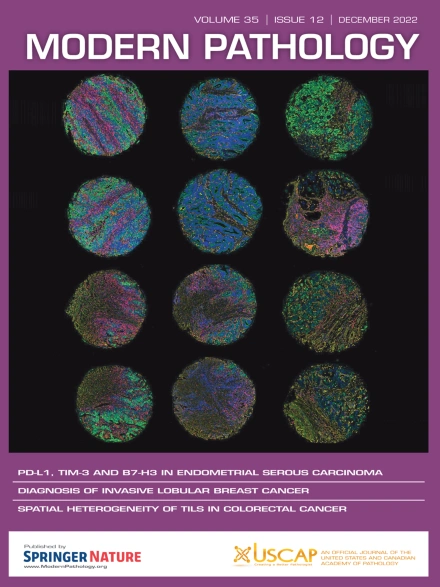早期非小细胞肺癌血液循环肿瘤 DNA 存在的临床病理预测因素。
IF 7.1
1区 医学
Q1 PATHOLOGY
引用次数: 0
摘要
全球肺癌筛查计划的实施引起了人们对改善早期肺癌检测和预后的极大关注。最近出现了几种检测循环肿瘤 DNA(ctDNA)的血液检测方法,它们是检测恶性肿瘤的非侵入性方法。然而,它们有限的灵敏度和预测价值仍然是临床应用的障碍。我们的目的是评估临床病理参数与临床I期非小细胞肺癌患者手术前ctDNA检测之间的关联,以进一步了解ctDNA脱落的生物学特性。研究对象包括接受肺癌切除术的180例腺癌(LUAD)和80例鳞状细胞癌(LUSC)I期患者。研究人员收集了患者的临床和病理特征。使用多重癌症早期检测测试(GRAIL LLC)通过靶向甲基化模式检测ctDNA。采用单变量和多变量模型评估了无细胞DNA肿瘤甲基化部分(TMeF)与临床病理预测因素之间的关系。与LUAD相比,LUSC与更高的TMeF相关。在LUSC和LUAD中,病理分期、肿瘤分级和肿瘤体积是ctDNA检测的关键决定因素。在 LUAD 中,ctDNA 的检测还与组织学形态组成、坏死、急性炎症有关,其次还与肺泡间隙扩散(STAS)和淋巴管侵犯有关。根据我们的研究结果,我们提出了LUAD(使用组织学模式组成)和LUSC(使用肿瘤分级和病理分期)的分类方法,以识别可能具有高ctDNA水平的患者。这些结果证实了之前的研究结果,并表明包括组织学模式组成和急性炎症在内的之前未确定的因素会影响ctDNA水平。这些结果将有助于了解ctDNA的脱落过程,并可确定哪些患者符合基于ctDNA检测的随访条件。本文章由计算机程序翻译,如有差异,请以英文原文为准。
Clinicopathological Predictors of the Presence of Blood Circulating Tumor DNA in Early-Stage Non–Small Cell Lung Cancers
The implementation of lung cancer screening programs across the world has drawn considerable attention to improving early-stage lung cancer detection and prognostication. Several blood-based assays detecting circulating tumor DNA (ctDNA) recently emerged as noninvasive methods to detect malignancies. However, their limited sensitivity and predictive value remain a hurdle to their clinical use. We aimed to evaluate the association between clinicopathological parameters and presurgical ctDNA detection in clinical stage I non–small cell lung cancer patients to further understand ctDNA shedding biology. The cohort included 180 adenocarcinomas (LUAD) and 80 squamous cell carcinomas (LUSC) stage I patients who underwent lung cancer resection. Patients’ clinical and pathological features were collected. A multicancer early-detection test (GRAIL LLC) was used to detect ctDNA using targeted methylation patterns. The association between the cell-free DNA tumor methylated fraction (TMeF) and the clinicopathological predictors was evaluated using univariate and multivariate modeling. LUSC was associated with a higher TMeF than LUAD. Pathological stage, tumor grade, and tumor volume were key determinants of ctDNA detection in both LUSC and LUAD. In LUAD, ctDNA detection also correlated with histologic pattern composition, necrosis, acute inflammation, and, to a lesser degree, spread through alveolar spaces and lymphovascular invasion. Based on our results, we propose classification methods for both LUAD (using histologic pattern composition) and LUSC (using tumor grade and pathological stage) to identify patients likely to have high ctDNA levels. These results confirm previous findings and suggest that previously unidentified factors, including histologic pattern composition and acute inflammation, influence ctDNA levels. These results will help in understanding the ctDNA shedding process and may allow identification of patients eligible for ctDNA detection–based follow-up.
求助全文
通过发布文献求助,成功后即可免费获取论文全文。
去求助
来源期刊

Modern Pathology
医学-病理学
CiteScore
14.30
自引率
2.70%
发文量
174
审稿时长
18 days
期刊介绍:
Modern Pathology, an international journal under the ownership of The United States & Canadian Academy of Pathology (USCAP), serves as an authoritative platform for publishing top-tier clinical and translational research studies in pathology.
Original manuscripts are the primary focus of Modern Pathology, complemented by impactful editorials, reviews, and practice guidelines covering all facets of precision diagnostics in human pathology. The journal's scope includes advancements in molecular diagnostics and genomic classifications of diseases, breakthroughs in immune-oncology, computational science, applied bioinformatics, and digital pathology.
 求助内容:
求助内容: 应助结果提醒方式:
应助结果提醒方式:


